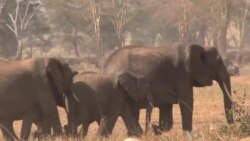TSAVO, KENYA —
Kenya is conducting an aerial census of the elephant population in a national park that has been the scene of gruesome poaching incidents in the last year. An intensive effort is underway to count and protect the threatened elephant population.
Pilots are taking to the skies above Tsavo National Park in eastern Kenya on a singular mission -- to find elephants.
The census, which takes place every three years, is organized by the Kenya Wildlife Service to map out the elephant population in the area.
Volunteers from organizations across the country have contributed their planes, including Save the Elephants and the David Sheldrick Wildlife Trust, which also donated all the fuel. The total cost of the exercise is about $200,000.
Scouring the park
Over the course of the week, pilots will cover nearly 50,000 square kilometers of land from the park here in Kenya to across the border in Tanzania in order to get a comprehensive count of the elephant population. Scientists hope they can use that data to better protect the species in the future."
The census is not just about population. Observers will also be looking for potential threats in the environment such as evidence of poaching.
Senior scientist with the Kenya Wildlife Service, Fredrick Lala, said, "This particular census is very important to us because apart from knowing the numbers, we will be able to know the areas where poaching has been able to occur, in terms of if we are able to identify the poaching areas. We'll also be able to know how the habitat is."
The good news is the elephant population appears to be increasing in Tsavo. It rose to 12,000 at the time of the last census, taken in 2011.
Unfortunately, the area suffered a spate of poaching incidents last year in which whole families of elephants were slaughtered for their ivory.
Engaging the locals
Other conflicts have arisen when the animals destroy farmland and other property.
Dickson Too, the senior warden for the Kenya Wildlife Service in Tsavo East, said engaging local population is key to protecting wildlife in the park.
"Of course, what we are doing, is we have a whole unit involved dealing with community issues that go out to the communities trying to create awareness -- because the most common thing is the human-wildlife conflict, and trying to teach them how to avoid such things happening," said Too.
Elephant monitoring groups estimate more than 25,000 elephants are killed across Africa each year, though the number could be higher.
Kenya recently enacted tough new laws raising the penalty for poaching and trading ivory.
But conservationists say until the demand for ivory -- coming mostly from China -- is stopped, there will be no end to the slaughter.
Pilots are taking to the skies above Tsavo National Park in eastern Kenya on a singular mission -- to find elephants.
The census, which takes place every three years, is organized by the Kenya Wildlife Service to map out the elephant population in the area.
Volunteers from organizations across the country have contributed their planes, including Save the Elephants and the David Sheldrick Wildlife Trust, which also donated all the fuel. The total cost of the exercise is about $200,000.
Scouring the park
Over the course of the week, pilots will cover nearly 50,000 square kilometers of land from the park here in Kenya to across the border in Tanzania in order to get a comprehensive count of the elephant population. Scientists hope they can use that data to better protect the species in the future."
The census is not just about population. Observers will also be looking for potential threats in the environment such as evidence of poaching.
Senior scientist with the Kenya Wildlife Service, Fredrick Lala, said, "This particular census is very important to us because apart from knowing the numbers, we will be able to know the areas where poaching has been able to occur, in terms of if we are able to identify the poaching areas. We'll also be able to know how the habitat is."
The good news is the elephant population appears to be increasing in Tsavo. It rose to 12,000 at the time of the last census, taken in 2011.
Unfortunately, the area suffered a spate of poaching incidents last year in which whole families of elephants were slaughtered for their ivory.
Engaging the locals
Other conflicts have arisen when the animals destroy farmland and other property.
Dickson Too, the senior warden for the Kenya Wildlife Service in Tsavo East, said engaging local population is key to protecting wildlife in the park.
"Of course, what we are doing, is we have a whole unit involved dealing with community issues that go out to the communities trying to create awareness -- because the most common thing is the human-wildlife conflict, and trying to teach them how to avoid such things happening," said Too.
Elephant monitoring groups estimate more than 25,000 elephants are killed across Africa each year, though the number could be higher.
Kenya recently enacted tough new laws raising the penalty for poaching and trading ivory.
But conservationists say until the demand for ivory -- coming mostly from China -- is stopped, there will be no end to the slaughter.















